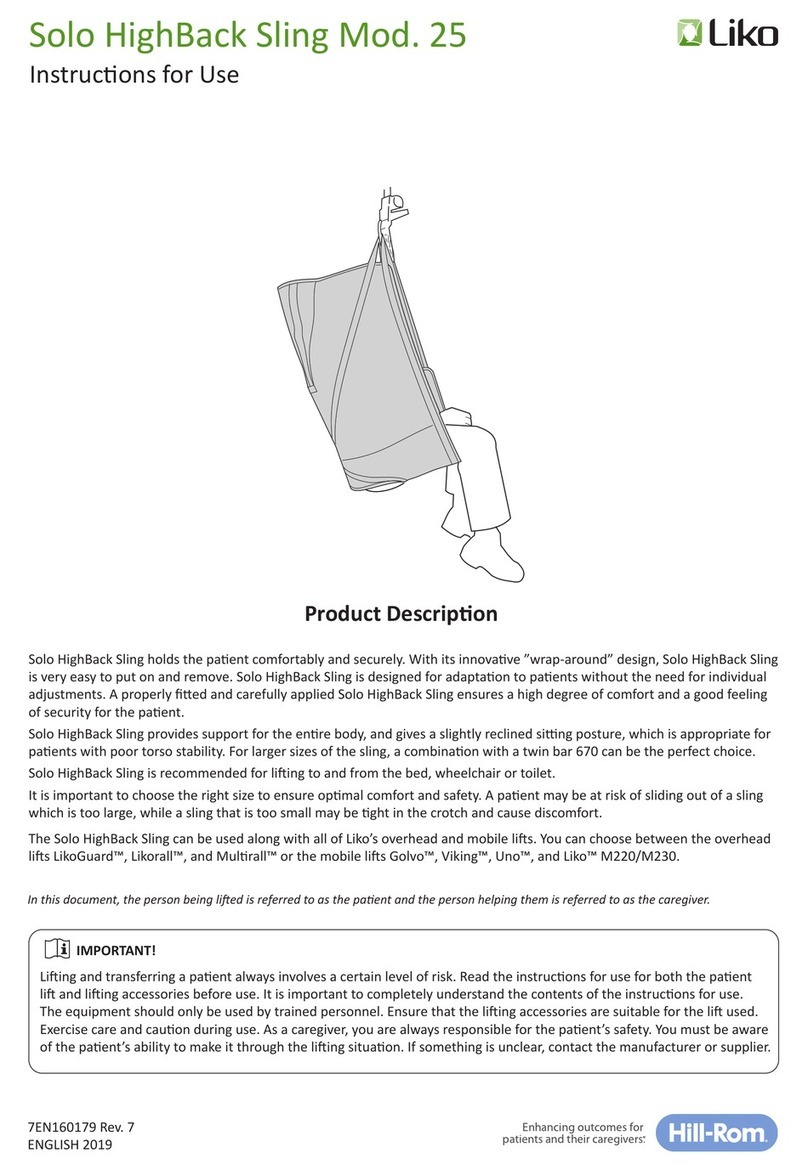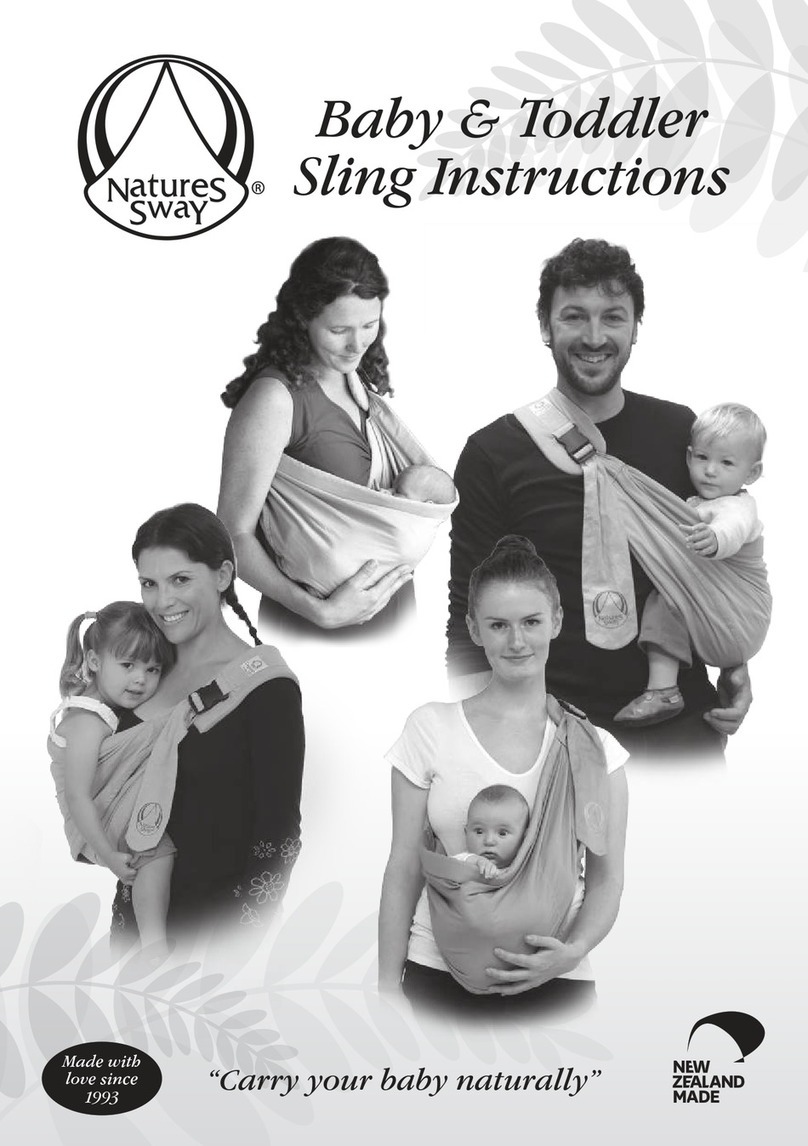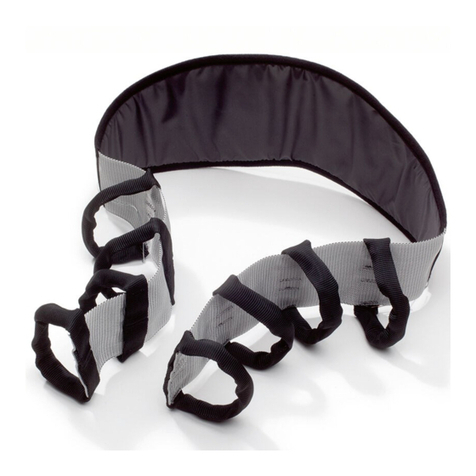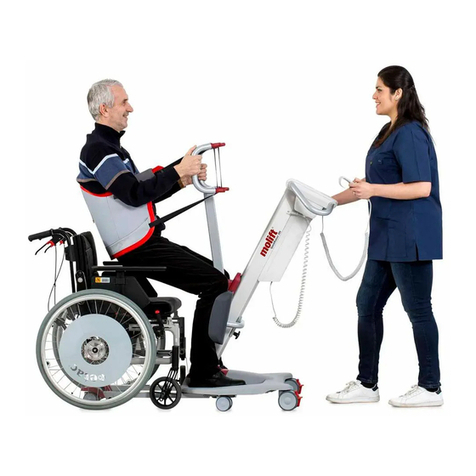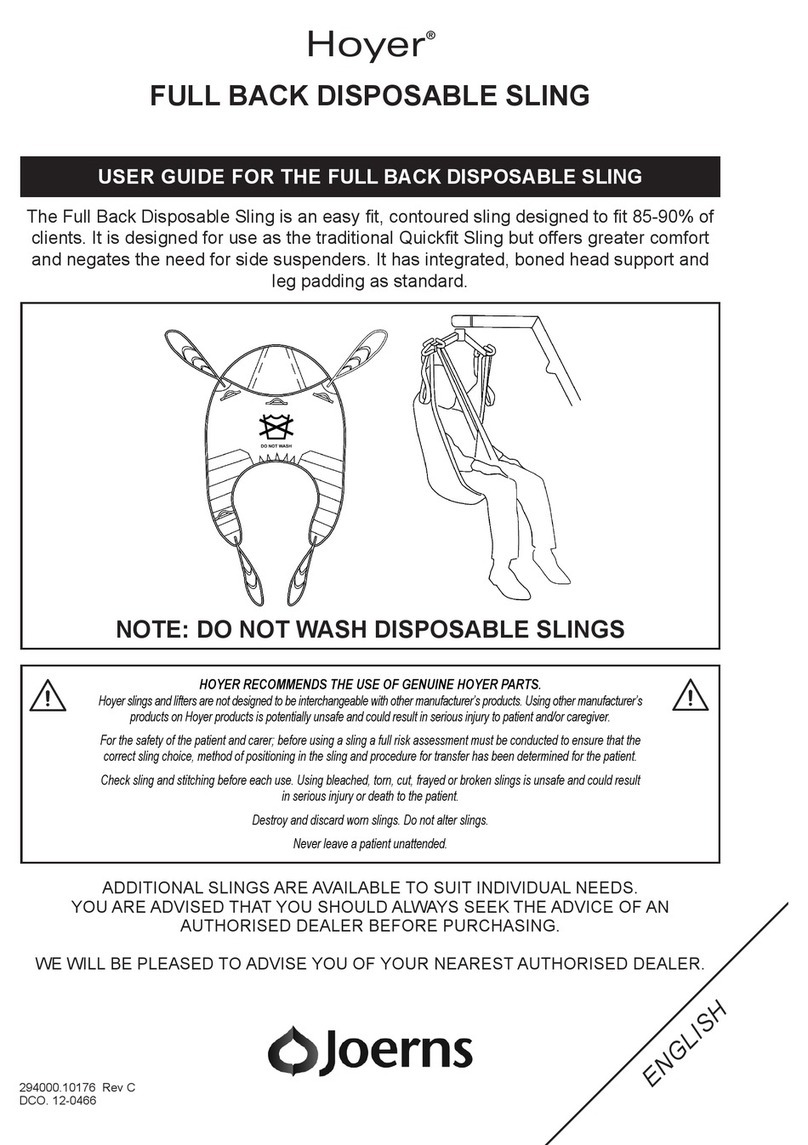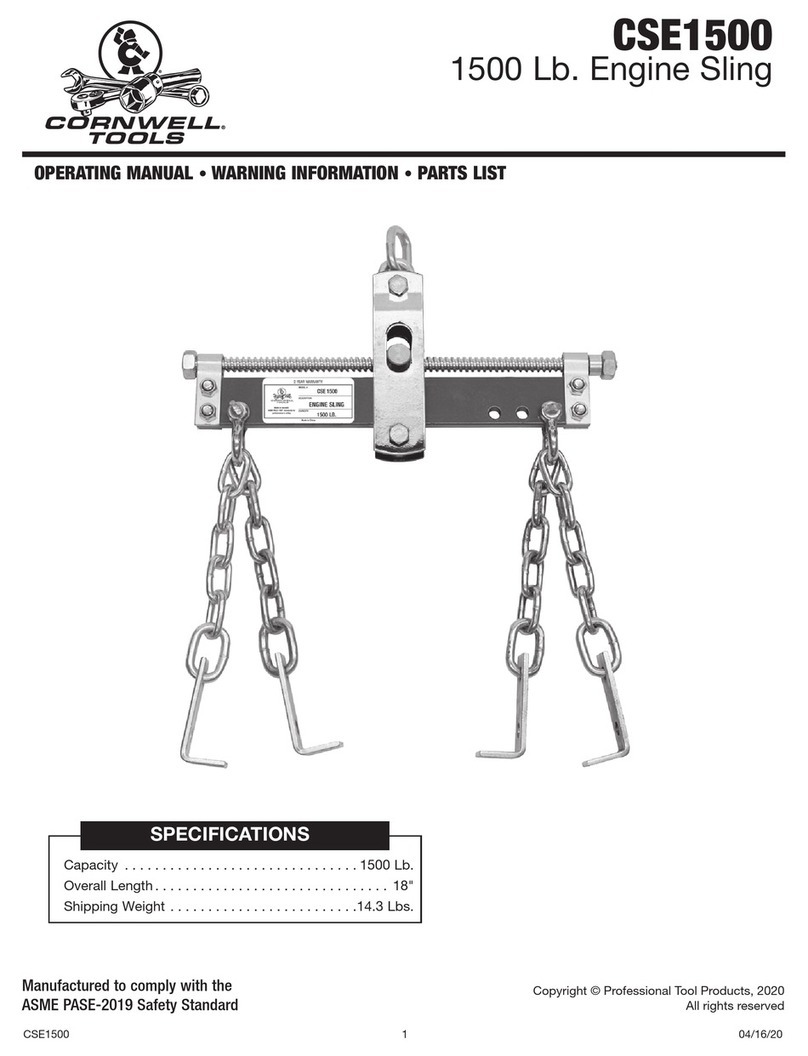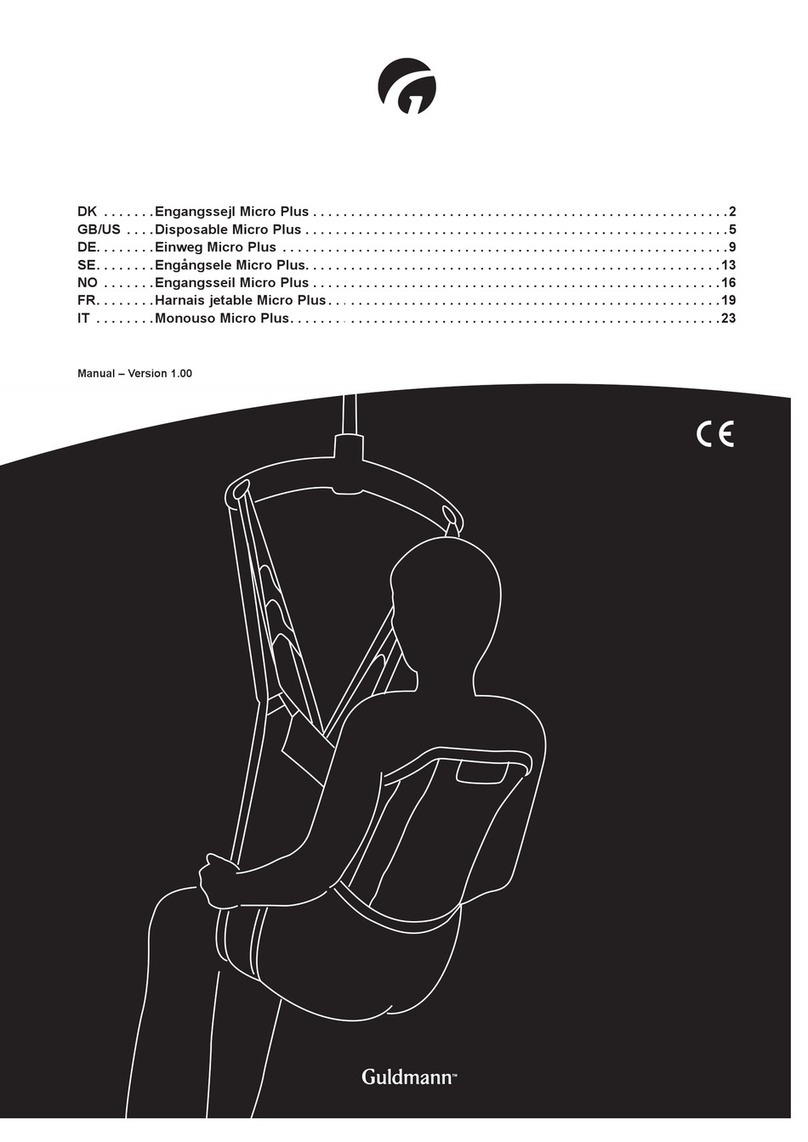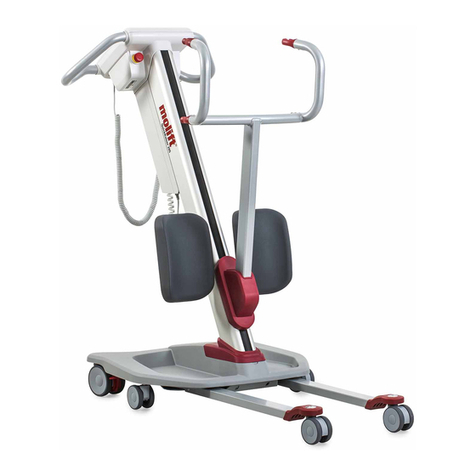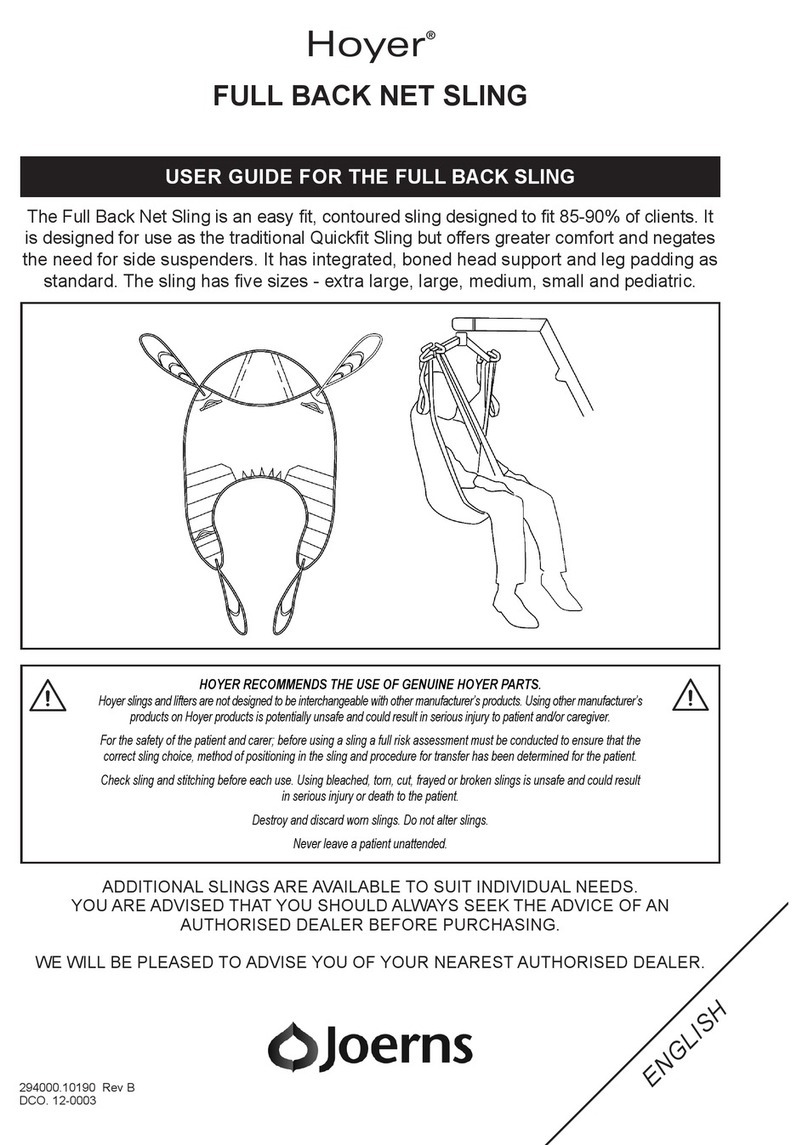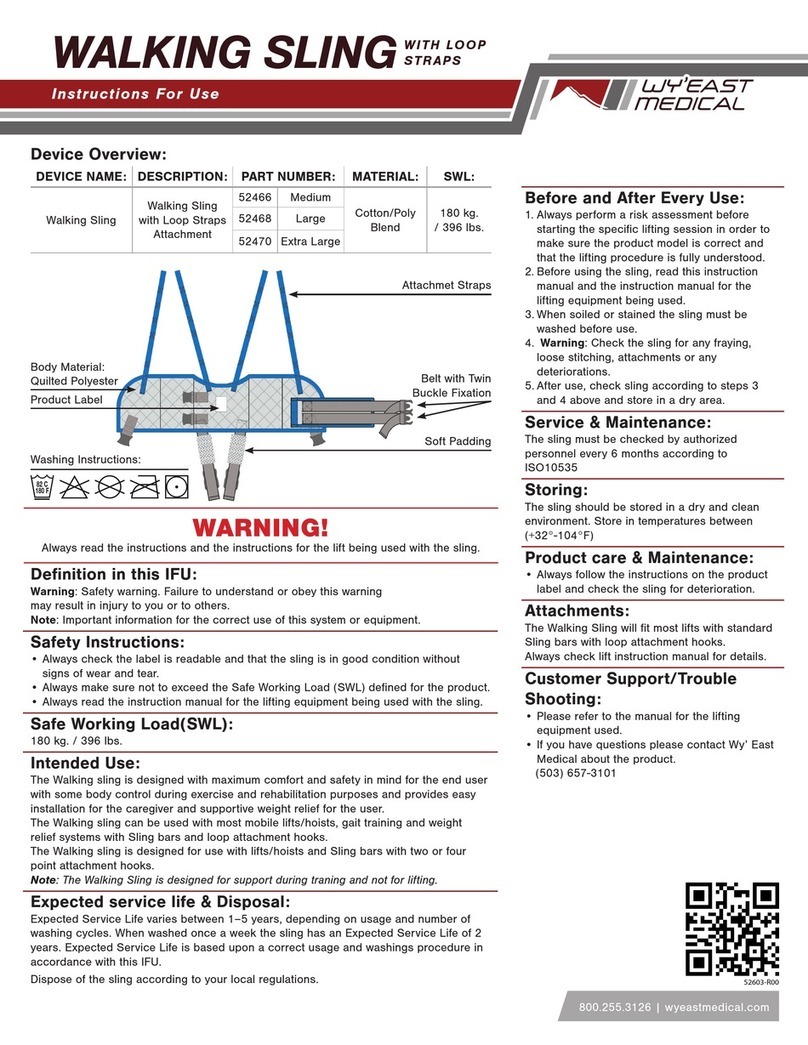Slingmax Twin-path User manual

0919a
Twin-path® sling
USER MANUAL
• Death or Injury can occur from improper use or care.
• For use only by a competent and/or qualied person as
dened by OSHA.
• Stay clear of the load at all times.
• Do not exceed rated capacity.
• Sling can fail if damaged, misused or overloaded.
• Inspect before each use. Damaged sling shall not be used.
• User shall protect sling from being cut by load edges, corners,
protrusions and abrasive surfaces.
• Do not expose to damaging chemicals and temperatures
over 180° F/ 82° C.
For additional important safety, inspection, removal and repair information, follow Slingmax®
Guidelines, ASME B30.9, WSTDA RS 1HP and Cordage Institute CI 1905 standards.

BEFORE EACH USE
DEATH or INJURY can occur from improper use or care.
1. Sling users shall be trained Do not use this sling unless you are properly trained.
See page 6 for training.
2. Read and follow all instructions and warnings in this manual.
3. Check tag to conrm that sling is adequately rated for the load. See page 7 for chart.
4. Inspect sling for damage including:
• Missing or unreadable Identication Tag
• Ensure Check-Fast® External Warning Indicator or tell-tail indicators extend past
the tag area of each sling
• If ber optics are installed, ensure light transmits from end to end
• Holes, tears, cuts, abrasive wear or snags
• Ensure inner red cover is not visible
• Acid or caustic burns
• Exposed core yarn
• Broken or damaged core yarn
• Weld splatter or heat damage
• Fittings that are pitted, corroded, cracked, bent, twisted, gouged or broken
• Any other condition, including visible damage, that causes doubt as to the
continued use of the sling
Inspection Frequencies
1. All slings and rigging shall be inspected before each use.
2. Documented periodic inspections shall be completed at least annually or more frequently
depending on service.
• Refer to ASME B30.9 and / or contact manufacturer for recommendations for
guidance on service intervals.
IF ANY OF THESE ARE DETECTED - SLING SHALL BE REMOVED FROM SERVICE IMMEDIATELY
1

1. Determine the weight and center of gravity of the load. For special lifts consult
manufacturer for additional support and/or suggested products.
2. Check the sling tag to conrm that the sling is rated adequately for the load in the
manner or hitches that it will be used. Refer to load angle, choke angle and other relevant
charts.
USE
45 30
90 60
1,000 lbs 866 lbs 707 lbs 500 lbs
LOAD ANGLE CHART
Angle factor must be applied to calculate the reduced sling
capacity when lifting force is not at 90˚ to the plane of the load!
Multiply angle factor x sling’s vertical rated load to
calculate the reduced capacity at the angle.
CHOKE ANGLE EFFECT
ANGLES OF
CHOKE
SLING RATED LOAD
100%
87%
74%
62%
49%
Over 120
90 - 120
60 - 89
30 - 59
0 - 29
Angle Factor Angle Factor Angle Factor Angle Factor
90˚
80˚
75˚
1.0000
0.9848
0.9659
70˚
65˚
60˚
55˚
50˚
45˚
40˚
35˚
30˚
0.9397
0.9063
0.8660
0.8192
0.7660
0.7071
0.6428
0.5736
0.5000
PERCENTAGE OF SLING RATED
CAPACITY IN A CHOKER HITCH
Use caution with lifts at angles less than 45˚and do not make lifts with slings at less than 30˚. When
possible, use longer slings to minimize angular tension by increasing the angle. Severe angles can
greatly reduce sling strength.
90° 60° 45° 30°
3. Check chemical resistance. Twin-Path® slings are generally resistant to common chemicals.
Resistances in this chart are based on common concentrations at room temperature. Elevated
concentrations and temperatures may aect chemical resistance. Contact Slingmax for more
information when using in environments with elevated concentrations of chemicals and/or
temperatures.
Chemical Resistance Chemical Resistance
Hydrocarbons Excellent Alkalis Excellent
Hydraulic Fluid Excellent Chlorine bleach Poor
Crude Oil Excellent Sodium Hydroxide Fair
Gasoline Excellent High Concentra�on Sodium Hydroxide Poor
Kerosene Excellent
Diesel Fuel Excellent Other
Mineral Oil Excellent Salt Water Excellent
Ammonia Fair
Acids Excellent
Sulfuric Acid Excellent Most Solvents Excellent
High Concentra�on Sulfuric Acid Fair Ethanol Excellent
Hydrochloric Acid Excellent Methanol Excellent
Phosphoric Acid Excellent Toluene Excellent
Boric Acid Excellent d-limonene Poor
2
Some chemicals on this chart (including those rated as“Excellent”) can damage the sling
cover. Contact Slingmax® for more information.

USE (Continued)
To avoid injury, it may be necessary to use multiple persons or an overhead
lifting device to lift the slings and rigging.
7. Protect sling from abrasive surfaces, pinch hazards, and edges. Use abrasion
protection for abrasive surfaces and cut protection for edges on the
hardware or load.
See page 5 for Cut and Abrasion Protection.
8. Ensure sling paths are smooth in the hitch without any twisting or bunching.
Sling shall not be twisted, tied into knots, or joined by knotting.
3
4. Be sure warning indication devices are operable.
Do not drag sling over any surface.
Do not expose to damaging chemicals and/or temperatures over 180˚F/82˚C.
Refer to manufacturer for additional information.
5. Select compatible ttings.
6. Center the sling and the load on the hardware being used. Avoid bunching the
sling. Do not fold sling, rather, push together.

USE (Continued)
9. Equalize the slack by hand. Do not equalize the sling by using the crane or hoist to
create tension.
Keep hands clear when the sling is being tightened.
10. Carefully lift the load.
Balance, maintain control and avoid sudden movement or jerking of the load.
Be alert for snagging of the load.
STAND CLEAR OF LOAD AT ALL TIMES.
DO NOT RIDE ON SLING OR LOAD.
STOP THE LIFT IMMEDIATELY if the load does not lift evenly, the external warning
indication devices react, or any other observed failure of the rigging is detected.
DISPOSAL
Before disposing of Twin-Path® slings, the slings shall be cut in half to prevent
inadvertent use.
Waste must be disposed of in accordance with national and local
environmental regulations.
CARE
Store slings to prevent contact with possible mechanical damage, corrosion, dust, grit
and extreme temperatures.
To clean: use mild soap and water and allow to air dry before storing.
Do not machine wash or dry, to avoid damaging the sling.
REPAIR
Field repair is not permitted. Return sling to a Slingmax® Dealer for repairs. Visit
www.slingmax.com for list of authorized Slingmax® Dealers.
Attempting to repair sling can result in sling failure, load drop, and death or serious
injury.
4

The CornerMax®Pad creates a “tunnel” of cut
protection which is known as the No Touch Zone.
The corner of the load does not come in contact
with the pad or the sling. The CornerMax®Pad is
specically designed to be used in 90˚angle
applications. Rated for 25,000 lbs per inch of sling
width.
CornerMax® Sleeve is made from tough high
performance ber that is specically woven to
provide cut protection for a variety of edges and
surfaces. CornerMax®Sleeves can be used in
many dierent angles and applications. Rated for
25,000 lbs per inch of sling width.
Synthetic Armor Pads protect slings from
abrasion damage that can be caused by contact
with rough surfaces such as concrete beams and
structures. They are also used to protect nished
or painted loads from marring. Synthetic Armor
can be made to t any length or width sling.
The pin area of a shackle can damage synthetic
slings. Placing synthetic slings on the pin should
be avoided. Shackles may have a sharp edge
where the pin goes through the shackle ear. If the
sling is rigged on this area, it could become
severely damaged. If you must rig on the pin,
protect your sling with a Shackle Pin Pad.
CUT AND ABRASION PROTECTION
Slings in contact with edges, corners, protrusions, abrasive surfaces or connecting hardware
shall be protected with a material of sucient strength, thickness and construction to prevent
damage. Cut protection shall be rated and labeled for its intended use.
Failure to use proper protection can result in sling failure, load drop, and death or serious
injury.
Available Abrasion Protection
Additional cut & abrasion protection information available from the manufacturer.
Available Cut Protection
5

Per ASME B30.9 & OSHA
Sling users shall be trained. Qualifying persons performing rigging
functions shall meet the applicable criteria and shall, through
education, training, experience, skill, and physical ability, as necessary,
be competent and capable to perform the job. Rigging training is widely
available through your local Slingmax®Dealer.
For training information please contact your local Slingmax®
Dealer or visit www.slingmax.com.
TRAINING & RESOURCES
ASSOCIATIONS
For additional information on the safe use, inspection, and training
requirements, please consult the standards and reference
items below:
• WSTDA-RS-HP1
• ASME B30.9
• CI 1905
• OSHA 29 CFR, 1910.184
• Slingmax Rigging Handbook
• Slingmax Smartphone App
6

For additional information visit our website
www.slingmax.com
Note: Capacies shown include both paths and are for one complete sling. Sling rangs based on commercial ngs of equal or greater
capacity. Conforms to ANSI/ ASME B30.9 Chapter 7, NAVFAC P-307 Secon 14.7.4.3, the Cordage Instute Roundsling Standard and the Web
Sling & Tie Down Associaon Roundsling Standard. This chart is based on a 5:1 Design Factor (DF) but any other DF can be fabricated. Higher
capacity slings are available. CAPACITIES ARE IN POUNDS (LBS.)
Twin-Path® Sling
Stock No.
Vercal Choker
Vercal
Basket
Basket Hitches Approximate
Weight
(Lbs. per Ft.)
(Bearing -
Bearing)
Nominal
Body Width
(Inches)*
Minimum
Recommended
Hardware
Diameter
(Inches)
Minimum
Bending
Radius
(Inches)
TPXCF/TPXC 1000
10,000
8,000
20,000
17,320
14,140
0.41
1.5 - 3"
0.63
0.32
TPXCF/TPXC 1500
15,000
12,000
30,000
25,980
21,210
0.45
1.5 - 3"
0.75
0.38
TPXCF/TPXC 2000
20,000
16,000
40,000
34,640
28,280
0.52
1.5 - 3"
0.86
0.43
TPXCF/TPXC 2500
25,000
20,000
50,000
43,300
35,350
0.66
2.0 - 4"
1.00
0.50
TPXCF/TPXC 3000
30,000
24,000
60,000
51,960
42,420
0.73
2.0 - 4"
1.10
0.55
TPXCF/TPXC 4000
40,000
32,000
80,000
69,280
56,560
0.86
2.0 - 4"
1.40
0.70
TPXCF/TPXC 5000
50,000
40,000
100,000
86,600
70,700
1.07
2.5 - 5"
1.50
0.75
TPXCF/TPXC 6000
60,000
48,000
120,000
103,920
84,840
1.20
2.5 - 5"
1.50
0.75
TPXCF/TPXC 7000
70,000
56,000
140,000
121,240
98,980
1.33
2.5 - 5"
1.84
0.92
TPXCF/TPXC 8500
85,000
68,000
170,000
147,220
120,190
1.60
3.0 - 6"
1.84
0.92
TPXCF/TPXC 10000
100,000
80,000
200,000
173,200
141,400
1.80
3.0 - 6"
2.00
1.00
TPXCF/TPXC 12500
125,000
100,000
250,000
216,500
176,750
2.30
4.0 - 8"
2.50
1.25
TPXCF/TPXC 15000
150,000
120,000
300,000
259,800
212,100
2.62
4.0 - 8"
2.50
1.25
TPXCF/TPXC 17500
175,000
140,000
350,000
303,100
247,450
2.95
4.0 - 8"
2.80
1.40
TPXCF/TPXC 20000
200,000
160,000
400,000
346,400
282,800
3.45
5.0 - 10"
3.00
1.50
TPXCF/TPXC 25000
250,000
200,000
500,000
433,000
353,500
4.10
5.0 - 10"
3.30
1.65
TPXCF/TPXC 27500
275,000
220,000
550,000
476,300
388,850
4.58
6.0 - 12"
3.62
1.81
TPXCF/TPXC 30000
300,000
240,000
600,000
519,600
424,200
4.91
6.0 - 12"
9.50
4.75
TPXCF/TPXC 40000
400,000
320,000
800,000
692,800
565,600
6.70
7.0 - 14"
9.50
4.75
TPXCF/TPXC 50000
500,000
400,000
1,000,000
866,000
707,000
8.48
8.0 - 16"
11.40
5.70
TPXCF/TPXC 60000
600,000
480,000
1,200,000
1,039,000
848,000
10.28
9.0 - 18"
11.40
5.70
TPXCF/TPXC 70000**
700,000
560,000
1,400,000
1,212,400
989,800
12.44
14.5 - 29"
14.30
7.15
TPXCF/TPXC 80000**
800,000
640,000
1,600,000
1,385,600
1,131,200
13.94
14.5 - 29"
14.30
7.15
*Dimensions can vary according to the hardware or bearing points the slings are used with.
Minimum is "tapered" width; Maximum is the at tubing width.
METRIC SLINGS AVAILABLE
**Tri-Path
90˚ 60˚ 45˚
Table of contents
